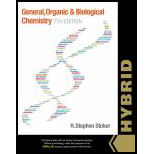
Interpretation:
Ionic form structural formula of the organic products that are formed from phosphorylation reaction of ethyl ester of diphosphoric acid with methyl alcohol has to be drawn.
Concept Introduction:
Esters are obtained when an acid react with an alcohol. If the considered acid is a
Phosphoric acid has three hydroxyl groups. Hence, it can form three types of esters. They are mono-, di-, and tri- ester of phosphoric acid. The ionic form of the phosphoric ester contains the terminal phosphate group. Transfer of the phosphoryl group from one molecule to another is known as phosphorylation reaction.
Want to see the full answer?
Check out a sample textbook solution
Chapter 16 Solutions
General, Organic, And Biological Chemistry, Hybrid (with Owlv2 Quick Prep For General Chemistry Printed Access Card)
- What is the purpose of sulfuric acid in synthesizing esters?arrow_forwardTo synthesize the ester called methyl ethanoate, the following alcohol and carboxylic acid can be mixed in the presence of an acid catalyst. methanol and methanoic acid ethanol and ethanoic acid propanol and ethanoic acid methanol and ethanoic acidarrow_forwardWrite the formula of each ester product in each of the esterification reactions.arrow_forward
 Organic And Biological ChemistryChemistryISBN:9781305081079Author:STOKER, H. Stephen (howard Stephen)Publisher:Cengage Learning,
Organic And Biological ChemistryChemistryISBN:9781305081079Author:STOKER, H. Stephen (howard Stephen)Publisher:Cengage Learning, General, Organic, and Biological ChemistryChemistryISBN:9781285853918Author:H. Stephen StokerPublisher:Cengage Learning
General, Organic, and Biological ChemistryChemistryISBN:9781285853918Author:H. Stephen StokerPublisher:Cengage Learning

